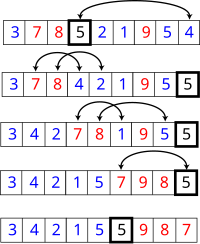【数据结构】——排序算法——2.2、快速排序
来源:互联网 发布:python django web开发 编辑:程序博客网 时间:2024/05/05 05:12
【数据结构】——排序算法——2.2、快速排序
一、先上维基的图:

图一、快速排序效果

图二、快速排序实例



二、描述
快速排序使用分治法(Divide and conquer)策略来把一个序列(list)分为两个子序列(sub-lists)。举个例子,军训时第一次集合,大家一时间混乱了,不知道怎么排,这时候教官随便抓了个人,说以该同学为基准,高的站左边,矮的站右边。此时,基本就把队伍分为高低两大阵营。那么,在每个小区间内,又进行同样的操作,迭代到每个区间内只有一个人,那么操作便结束了!
步骤为:
- 从数列中挑出一个元素,称为"基准"(pivot),
- 重新排序数列,所有元素比基准值小的摆放在基准前面,所有元素比基准值大的摆在基准的后面(相同的数可以到任一边)。在这个分区退出之后,该基准就处于数列的中间位置。这个称为分区(partition)操作。
- 递归地(recursive)把小于基准值元素的子数列和大于基准值元素的子数列排序。
递归的最底部情形,是数列的大小是零或一,也就是永远都已经被排序好了。虽然一直递归下去,但是这个算法总会退出,因为在每次的迭代(iteration)中,它至少会把一个元素摆到它最后的位置去。
三、Java程序非wiki版:
public class Qsorta {public static void qsort_asc(int source[], int low, int high){int i, j , x;if(low < high){i = low;j = high;x = source[i];while(i<j){while(i<j&& source[j]>x ){j--;}if(i<j){source[i] = source[j];i++;}while(i<j&& source[i] < x){i++;}if(i<j){source[j] = source[i];j--;}}source[i] = x;qsort_asc(source,low, i-1);qsort_asc(source,i+1, high);}}public static void main(String[] args){int[] a = {4,2,1,6,3,6,0,-5,1,1,85};int i;qsort_asc(a,0,a.length-1);for(i=0;i<a.length-1;i++) System.out.println("a" + i + " is "+a[i]);}}wiki版:
import java.util.Comparator;import java.util.Random; public class Quicksort { public static final Random RND = new Random(); private static void swap(Object[] array, int i, int j) { Object tmp = array[i]; array[i] = array[j]; array[j] = tmp; } private static <E> int partition(E[] array, int begin, int end, Comparator<? super E> cmp) { int index = begin + RND.nextInt(end - begin + 1); E pivot = array[index]; swap(array, index, end); for (int i = index = begin; i < end; ++ i) { if (cmp.compare(array[i], pivot) <= 0) { swap(array, index++, i); } } swap(array, index, end); return (index); } private static <E> void qsort(E[] array, int begin, int end, Comparator<? super E> cmp) { if (end > begin) { int index = partition(array, begin, end, cmp); qsort(array, begin, index - 1, cmp); qsort(array, index + 1, end, cmp); } } public static <E> void sort(E[] array, Comparator<? super E> cmp) { qsort(array, 0, array.length - 1, cmp); } } /* * more efficient implements for quicksort. <br /> * use left, center and right median value (@see #median()) for the pivot, and * the more efficient inner loop for the core of the algorithm. */class Sort { public static final int CUTOFF = 11; /** * quick sort algorithm. <br /> * * @param arr an array of Comparable items. <br /> */ public static <T extends Comparable<? super T>> void quicksort( T[] arr ) { quickSort( arr, 0, arr.length - 1 ); } /** * get the median of the left, center and right. <br /> * order these and hide the pivot by put it the end of * of the array. <br /> * * @param arr an array of Comparable items. <br /> * @param left the most-left index of the subarray. <br /> * @param right the most-right index of the subarray.<br /> * @return T */ public static <T extends Comparable<? super T>> T median( T[] arr, int left, int right ) { int center = ( left + right ) / 2; if ( arr[left].compareTo( arr[center] ) > 0 )swapRef( arr, left, center );if ( arr[left].compareTo( arr[right] ) > 0 )swapRef( arr, left, right );if ( arr[center].compareTo( arr[right] ) > 0 )swapRef( arr, center, right ); swapRef( arr, center, right - 1 );return arr[ right - 1 ]; } /** * internal method to sort the array with quick sort algorithm. <br /> * * @param arr an array of Comparable Items. <br /> * @param left the left-most index of the subarray. <br /> * @param right the right-most index of the subarray. <br /> */ private static <T extends Comparable<? super T>> void quickSort( T[] arr, int left, int right ) {if ( left + CUTOFF <= right ) {//find the pivotT pivot = median( arr, left, right ); //start partitioningint i = left, j = right - 1;for ( ; ; ) {while ( arr[++i].compareTo( pivot ) < 0 ) ;while ( arr[--j].compareTo( pivot ) > 0 ) ;if ( i < j )swapRef( arr, i, j );elsebreak;} //swap the pivot reference back to the small collection.swapRef( arr, i, right - 1 ); quickSort( arr, left, i - 1 );//sort the small collection.quickSort( arr, i + 1, right );//sort the large collection. } else {//if the total number is less than CUTOFF we use insertion sort instead (cause it much more efficient).insertionSort( arr, left, right );} } /** * method to swap references in an array.<br /> * * @param arr an array of Objects. <br /> * @param idx1 the index of the first element. <br /> * @param idx2 the index of the second element. <br /> */ public static <T> void swapRef( T[] arr, int idx1, int idx2 ) {T tmp = arr[idx1];arr[idx1] = arr[idx2];arr[idx2] = tmp; } /** * method to sort an subarray from start to end * with insertion sort algorithm. <br /> * * @param arr an array of Comparable items. <br /> * @param start the begining position. <br /> * @param end the end position. <br /> */ public static <T extends Comparable<? super T>> void insertionSort( T[] arr, int start, int end ) {int i;for ( int j = start + 1; j <= end; j++ ) {T tmp = arr[j];for ( i = j; i > start && tmp.compareTo( arr[i - 1] ) < 0; i-- ) {arr[ i ] = arr[ i - 1 ];}arr[ i ] = tmp;} }} 0 0
- 数据结构【排序算法】——快速排序
- 【数据结构】——排序算法——2.2、快速排序
- 【数据结构与算法】排序算法——快速排序
- 【数据结构与算法】排序算法——快速排序
- 数据结构 — 快速排序
- 数据结构与算法——快速排序
- 数据结构——快速排序算法
- 数据结构与算法——快速排序
- 数据结构算法——快速排序
- 数据结构与算法——快速排序
- 排序算法—快速排序
- 排序算法—快速排序
- 数据结构—排序算法
- 数据结构 — 排序算法
- 数据结构——快速排序
- 数据结构——快速排序
- 数据结构——快速排序
- 数据结构—快速排序模型
- 向阮一峰致敬
- design_pattern_derivative_exotic_option
- HTML5图像操作
- 北大ACM试题1007
- 第二周项目1程序阅读
- 【数据结构】——排序算法——2.2、快速排序
- JAVA设置JDK环境变量参数
- 黑马程序员——Java编程语言学习总结 – 循环与选择性语句
- 新学期
- git获取spring-mvc-quickstartarchetype及安装到Maven
- 100小时学会SAP.Day0
- 自我检讨
- 面向对象思想是什么
- 求转置矩阵问题


